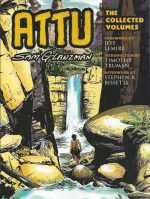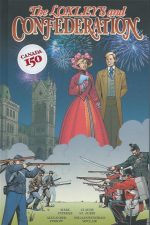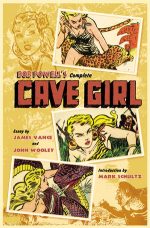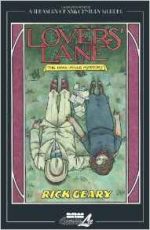
By Joe Kubert with Robert Kanigher, Russ Heath & various (Dark Horse Comics)
ISBN: 978-1-59307-417-3
The early 1970s were the last real glory days of National/DC) Comics. As they slowly lost market-share to Marvel they responded by producing controversial and landmark superhero material, but their greatest strength lay, as it always has, in the variety and quality of its genre divisions. Mystery and Supernatural thrillers, Science Fiction, Romance, War and Kids’ titles remained powerful attractions and the company’s eye for a strong licensed brand was as keen as ever.
A global multi-media phenomenon, Edgar Rice Burroughs’ Tarzan had long been a comicbook mainstay of Dell/Gold Key/Whitman, and when DC acquired the title they rightly trumpeted it out, putting one of their top Artist/Editors, Joe Kubert, in charge of the immortal Ape-man’s monthly exploits.
After decades as Whitman staples, total licensing of ERB properties was transferred to DC – not just Tarzan and his extended family, but also the author’s pioneering science fantasy characters – with DC wisely continuing the original numbering.
Tarzan #207 was the first (with an April 1972 cover-date) and the series stormed, garnering great acclaim until #258 in February 1977. Thereafter Marvel, Malibu, Dark Horse and Dynamite extended the Jungle Lord’s comicbook canon in sporadic sorties to recapture the sales and popularity of the 1950s…
The latter days of the Gold Key run had suffered ever since Russ Manning left the title to draw the syndicated newspaper strip, and even the likes of Doug Wildey were unable to revive the comic’s success in the face of constantly rising costs and a general downturn in sales across the market. DC’s continuation of the franchise premiered in a blaze of publicity at the height of a nostalgia boom and was generally well-received by fans.
DC pushed the title in many places and formats (such as bookstore digest collections and the gloriously oversized Tabloid Editions) and adapted other properties such as John Carter of Mars, Pellucidar and Carson of Venus in their own features and titles.
This third and final fabulous hardcover archive collection (also available in digital formats) re-presents material from Tarzan #225-235, covering November 1973 through February/March 1975 and concluding the master’s interior artistic contributions – writing, illustrating and lettering.
After more fond reminiscences in Kubert’s Introduction, the pictorial wonderment resumes with original tale ‘Moon Beast’ which sees a mother and child brutally slaughtered and Tarzan framed for the hideous crime by cunning medicine man Zohar. When the vile trickster overreaches himself, the captive Ape-Man breaks free but still has to deal with the mutant brute Zohar employed to perpetrate the atrocity…
Kubert only produced the cover for #226 as the crushing deadline pressures finally caught up with him. The contents – not included here – featured a retelling of the Ape-Man’s origins by Russ Manning, taken from the Sunday newspaper strips of 15th November 1970-7th February 1971.
Back in control for #227, Joe took Tarzan out of his comfort zone as ‘Ice Jungle’ saw young native warrior Tulum endure a manhood rite at the top of a mountain. Also converging on the site for much the same reason is American trust-fund brat J. Pellington Stone III, determined to impress his father by bagging a legendary snow ape. Sensing impending doom, Tarzan follows them both and is not wrong in his assessment…
After single-handedly killing an immense Sabretooth tiger in an unexplored region of the continent, Tarzan is captured by pygmies intent on offering him as to a mighty monster who has terrorised them for years. However, his ‘Trial By Blood!’ sees Tarzan cleverly outwit the giant lizard and teach the tribal elders a valuable lesson in leadership, after which albino queen Zorina seeks to extend her power by making him her consort.
The Ape-Man wants nothing to do with ‘The Game!’, and, after the kingdom descends into savage civil war, sees ironic Fate deal the white queen a telling death blow…
With Tarzan #230 (April/May 1974), the title transformed into a sequence of 100-page giants, mixing new material with reprints of ERB characters and thematically-aligned stars from DC’s vast back-catalogue.
Leading off that issue was a brief all-Kubert vignette as ‘Tarzan’ saved a deer from a lioness which neatly segued into ‘Leap into Death’ starring Korak, Son of Tarzan, written by Robert Kanigher, drawn by Kubert and inked by Russ Heath.
Here the titanic teen nomad hunted for his stolen true love Meriem and the barbarian Iagho who had taken her, before stumbling into a nest of aggressively paranoid bird-people who learned to respect his courage but still flew away with his lover…
The next issue featured the start of another-Kubert-adapted Burroughs novel: possibly the most intriguing conception of the entire canon.
‘Tarzan and the Lion Man Part One’ saw a movie company on location in the deep jungle to make a picture about a white man raised by animals to become undisputed master of all he surveyed. The chain of coincidences grew more improbable as actor Stanley Obroski was a dead ringer for Tarzan… which probably explained why he was taken by savages set on torturing him to death…
Rescued by Tarzan, Stanley explained how the expedition was attacked, unaware exactly how much trouble his fellow actors were in. During Obroski’s absence, stand-in Rhonda Terry and starlet Naomi Madison were kidnapped by El Ghrennem‘s Arab bandits who believed the production’s prop map actually led to a valley of diamonds…
When Tarzan found the rest of the film crew he was mistaken for Stanley and drawn into their search for the missing women. The plucky Americans had already made a mad dash for freedom, however, and Rhonda had been captured by creatures she simply could not believe…
After a fascinating bonus section revealing Kubert’s ‘Layouts and Thumbnails’ for the opening chapter, ‘Tarzan and the Lion Man Part Two’ sees Rhonda taken by apes who speak Elizabethan English, and made the subject of a fierce debate. Half of the articulate anthropoids want to take her to “God†whilst the other faction believes her a proper prize of their liege lord “King Henry VIIIâ€â€¦
After being briefly recaptured by El Ghrennem, Naomi too is taken by the talkative Great Apes. When Tarzan discovers the kidnapper’s corpses he follows the trail up an apparently unscalable escarpment. Rescuing and returning Miss Madison to her surviving friends, Tarzan/Stanley then returns to ascend the stony palisade and discover an incredible pastoral scene complete with feudal village and English castle…
Tracking Rhonda, he enters the citadel and meets a bizarre human/ape hybrid calling himself God. The garrulous savant explains that once he was simply a brilliant Victorian scientist pursuing the secrets of life. When his unsavoury methods of procuring test subjects forced him to flee England and relocate to this isolated region of Africa, he eventually resumed his experiments and transformed himself into a superior being and apes into fitting servants.
Now they have a society of their own – based on the history books he brought with him – and his experiments are nearing completion. Having already extended his life and vitality far beyond its normal span by experimenting upon himself, God is now ready to attain immortality and physical perfection. All he has to do is consume Tarzan…
Of course the madman has no conception of his captive’s capabilities, and when the Ape-Man and Rhonda promptly vanish from their dungeon it sends the palace into turmoil and God into a paroxysm of insanity…
The chaos also prompts already ambitious apostate King Henry to begin a revolution to overthrow his creator. As ‘Tarzan and the Lion Man Part Three‘ opens, the war between Church and State is in full swing and Tarzan battles to rescue Rhonda whilst God’s castle becomes a flaming hell.
Losing her in the chaos Tarzan is forced into a hasty alliance with God, unaware that maniacal monarch Henry has taken her back to the jungles below the escarpment and into a region where God casts his scientific failures…
All too soon Henry is dead and Rhonda is facing beings even stranger than talking apes. Thankfully ‘Tarzan and the Lion Man Part Four‘ sees “Stanley†arrive in time to save her from incredible peril and return her to the film party in the dazzling, tragic conclusion…
Kubert then ended his close association with Tarzan in #235’s ‘The Magic Herb’. After the jungle hero saves a couple from a crashed aeroplane, siblings Tommy and Gail urge him to help them find a legendary flower that might cure the man’s fatal ailment. However, something about them makes Tarzan suspicious…
Nevertheless he takes them to the primeval lost valley where it grows, only to be betrayed as the intruders frame him: throwing the jungle lord to the resident lizard men whilst they make off with specimens that will make them millionaires in the outside world.
Sadly, the treacherous pair have completely misunderstood the powers of the plant and pay the ultimate price all betrayers must…
Wrapping up the astounding thrills and captivating artistry (splendidly remastered by Sno Cone Studious and Jason Hvam) is a revelatory selection of drawings from ‘Joe Kubert’s Sketchbook’ tracing the art process from page-roughs to competed page
Supplemented by Creator Biographies of Burroughs and Kubert, this tome is another unmissable masterpiece of comics creation and wild adventure no lover of the medium or fantasy fan can afford to be without.
Edgar Rice Burroughs’ Tarzan ® The Joe Kubert Years Volume Two © 1973, 1974, 1975, 2006 Edgar Rice Burroughs, Inc. All rights reserved. Tarzan ® is owned by Edgar Rice Burroughs Inc., and used by permission.









